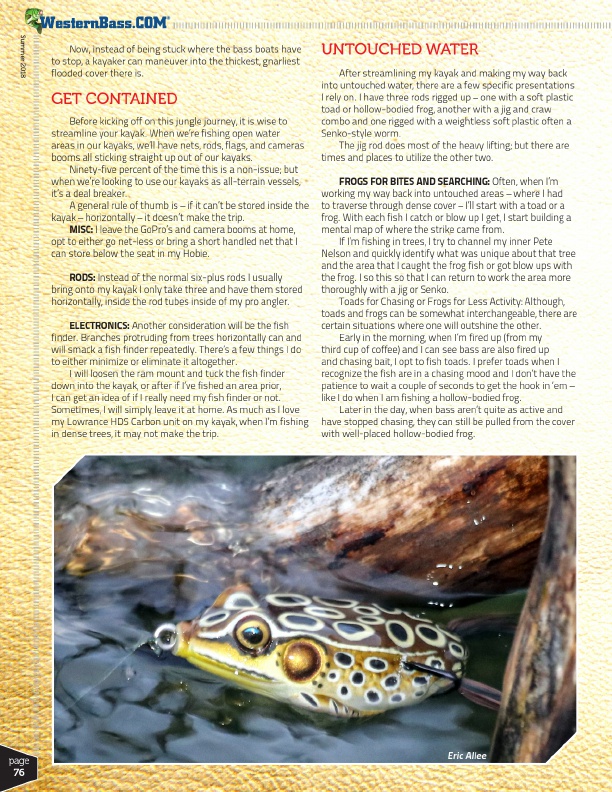
Summer 2018
®
Now, instead of being stuck where the bass boats have to stop, a kayaker can maneuver into the thickest, gnarliest flooded cover there is.
GET CONTAINED
Before kicking off on this jungle journey, it is wise to streamline your kayak. When we’re fishing open water areas in our kayaks, we’ll have nets, rods, flags, and cameras booms all sticking straight up out of our kayaks.
Ninety-five percent of the time this is a non-issue; but when we’re looking to use our kayaks as all-terrain vessels, it’s a deal breaker.
A general rule of thumb is – if it can’t be stored inside the kayak – horizontally – it doesn’t make the trip.
MISC: I leave the GoPro’s and camera booms at home, opt to either go net-less or bring a short handled net that I can store below the seat in my Hobie.
RODS: Instead of the normal six-plus rods I usually bring onto my kayak I only take three and have them stored horizontally, inside the rod tubes inside of my pro angler.
ELECTRONICS: Another consideration will be the fish finder. Branches protruding from trees horizontally can and will smack a fish finder repeatedly. There’s a few things I do to either minimize or eliminate it altogether.
I will loosen the ram mount and tuck the fish finder down into the kayak, or after if I’ve fished an area prior, I can get an idea of if I really need my fish finder or not. Sometimes, I will simply leave it at home. As much as I love my Lowrance HDS Carbon unit on my kayak, when I’m fishing in dense trees, it may not make the trip.
UNTOUCHED WATER
After streamlining my kayak and making my way back into untouched water, there are a few specific presentations I rely on. I have three rods rigged up – one with a soft plastic toad or hollow-bodied frog, another with a jig and craw combo and one rigged with a weightless soft plastic often a Senko-style worm.
The jig rod does most of the heavy lifting; but there are times and places to utilize the other two.
FROGS FOR BITES AND SEARCHING: Often, when I’m working my way back into untouched areas – where I had to traverse through dense cover – I’ll start with a toad or a frog. With each fish I catch or blow up I get, I start building a mental map of where the strike came from.
If I’m fishing in trees, I try to channel my inner Pete Nelson and quickly identify what was unique about that tree and the area that I caught the frog fish or got blow ups with the frog. I so this so that I can return to work the area more thoroughly with a jig or Senko.
Toads for Chasing or Frogs for Less Activity: Although, toads and frogs can be somewhat interchangeable, there are certain situations where one will outshine the other.
Early in the morning, when I’m fired up (from my third cup of coffee) and I can see bass are also fired up and chasing bait, I opt to fish toads. I prefer toads when I recognize the fish are in a chasing mood and I don’t have the patience to wait a couple of seconds to get the hook in ‘em – like I do when I am fishing a hollow-bodied frog.
Later in the day, when bass aren’t quite as active and have stopped chasing, they can still be pulled from the cover with well-placed hollow-bodied frog.
page
76
Eric Allee